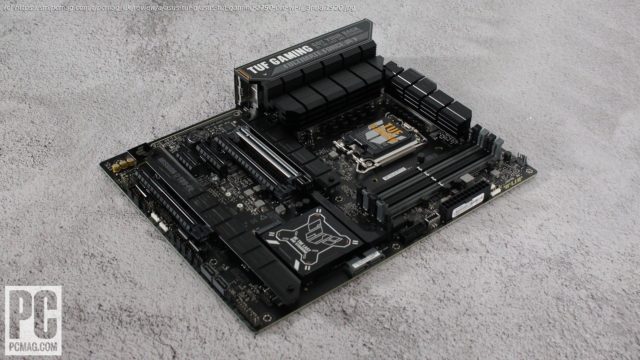TUF enough for 14th Gen CPUs, and easy enough on the wallet
The Asus TUF Gaming Z790-Pro Wi-Fi motherboard is an iterative update from the company’s Z790-Plus Wi-Fi. Like its predecessor, it’s a budget-priced Z790 offering that promises game-ready features and proven durability; Asus’ TUF motherboards are engineered with military-grade components, upgraded power, a comprehensive cooling system for extended-use scenarios, AI Overclocking, and Asus Enhanced Memory Profile II (RAM) capabilities. Priced at $279.99, the Z790-Pro is one of the more affordable Z790 “Raptor Lake Refresh” options, despite offering a complete list of features including four M.2 sockets, capable power delivery, a last-gen premium audio solution, and several rear USB ports including a 20Gbps Type-C port.Board Design, CPU, and Memory
In looking at the design of the refreshed TUF board, we can see that the differences in appearance between the Z790-Plus and Z790-Pro aren’t significant. The newer motherboard still comes with large heatsinks and shrouds covering most of what’s needed on the 6-layer PCB. (One M.2 socket has no heatsink.) The VRM heatsinks have enough mass and surface area (due to deep miter cuts) to be effective at their jobs.
The same miter or notched look replaces the geometric design found on the previous board’s M.2 heatsinks, yielding a uniform appearance. If you crave some RGB bling, the TUF Gaming Z790-Pro has just one small area that shines through the PCB on the right edge. (The Plus, in contrast, had two.) It’s a visually simple implementation, as you’d expect at this price, but it should fit in well with most build themes. It just won’t be the brightest thing in your chassis.
The TUF Gaming Z790-Pro Wi-Fi natively supports Intel’s 12th through 14th Generation LGA 1700 processors, including the flagship Core i9-14900K and 14900KS. The 16 60A MOSFETs and TUF chokes dedicated to the processor handled our high-power CPU without a hitch during testing. The heatsinks kept the power bits underneath running well within spec, even when overclocking, though they did tend to get warm in extended high-load situations. Additional airflow isn’t strictly necessary, but it couldn’t hurt if you push these high-wattage processors.
Memory support is listed up to DDR5-7800+ (OC), up from DDR5-7200 for the Plus, which tops most of the board’s direct competition. If you need a lot of memory, the four DRAM slots support up to 192GB, which is plenty for even the most hardcore home users. The RAM is secured by a single-sided locking mechanism (locks on top, where there is room to access them).
Our DDR5-6000 kit proved perfectly stable by setting the internal XMP profile, and our fastest kit (DDR5-7200) also ran well. If that’s not enough for you, there are plenty of sub-timings to tweak in the BIOS to get another iota or two of performance. One cool feature is the Asus Enhanced Memory Profile (AEMP II) found in the AI Overclocking part of the UEFI, which allows for automatic memory overclocking when the DDR5 lacks XMP or EXPO profiles. Since this is a budget board, users often buy less expensive RAM that’s JEDEC-rated only without XMP profiles. The AEMP II technology automatically overclocks the memory for you, letting you put the money saved toward something else in your build or back in the bank.Layout and Internal Connectors
Starting our tour at top left, we run into the two 8-pin EPS power connectors (one required) to power the processor. Flanking these are two large VRM heatsinks to cool the power bits hiding underneath. The rear I/O cover sports the TUF branding and a couple of mottos such as “BE THE LAST ONE STANDING.” I prefer designs to words, myself, but it doesn’t detract from the appearance.
Just above the top VRM heatsink are the first two of seven fan headers. Each supports PWM and DC-controlled devices and is able to output up to 1A/12W. This should be plenty for most fans, but if plan to use a custom water-cooling loop, be sure anything you connect doesn’t exceed that amount or you could damage the motherboard. Control over these devices is handled through the BIOS or Asus’ Armory Crate software.






